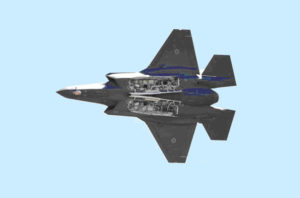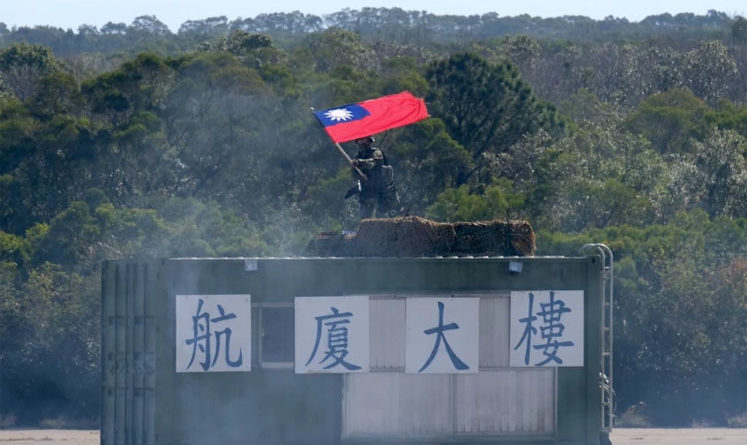What The US Should Do About Taiwan
By Stephen Bryen
October 5, 2021
Words from Washington are not enough as Chinese warplanes step up their provocative incursions into Taiwan’s airspace

A Republic of China (Taiwan) Air Force F-16 fighter aircraft, left, flying alongside a Chinese People’s Liberation Army Air Force H-6K bomber in 2018. China has recently stepped up its incursions into Taiwan’s airspace. Photo: AFP / Taiwan Defense Ministry
No one can doubt that China is very close to attacking Taiwan. The latest incursion of 52 warplanes on Monday, which included 36 fighters and 12 nuclear bombers plus surveillance aircraft, was much more than just a demonstration.
Taiwan so far has exercised restraint, putting its F-16s and other aircraft into the sky to challenge Chinese incursions into its air defense zone (ADIZ) but not firing on the intruding aircraft. But if a mistake happens, it will end up a bloody mess.
The US State Department had issued a strong statement condemning China’s violations of Taiwan’s ADIZ even before China responded by sending in 52 warplanes on Monday. It appears that China does not take Washington seriously and doesn’t care at all what the State Department says.
Is Joint Chiefs of Staff chairman General Mark Milley calling his counterparts in China and telling them not to worry? It is a fair question, although he probably hasn’t. On the other hand, the Pentagon is far from ready to take on China and won’t push the White House to do anything.
The Pentagon’s reluctance is based on a number of war games and simulations that suggest in any conflict with China, the US will be defeated. So even if President Biden asks, it is likely he will get a lot of pushback from the Defense Department, particularly from the Joint Chiefs of Staff.

Chairman of the Joint Chiefs of Staff General Mark A Milley, Secretary of Defense Lloyd Austin and General Kenneth McKenzie, commander of the US Central Command on September 29, 2021, in Washington. Photo: AFP / Getty Images
On the other hand, if Taiwan were to fall to China without US intervention, Biden’s presidency, already tottering, would likely collapse. Biden would have to resign and Vice President Kamala Harris would become president, unless she is also forced to step aside. No one has any idea of what would happen in such a scenario.
Along with the loss of Taiwan and the high human cost, the US would also lose access to vital integrated circuits that support its high-tech and automobile industries and defense manufacturing. The entire mess could be a big blow to the US and global economy, and lead to upheavals everywhere, including in China.
One result, to be dreaded, might be the establishment of military-run governments in many affected countries, even the United States and almost certainly in China.
Keep in mind that the Covid pandemic has led to the abrogation of constitutional rights in the US in a manner unprecedented by other national crises, even the suspension of habeas corpus (allowing detention of persons without recourse to the courts) by President Lincoln. The draconian Covid measures have driven a stake into the heart of constitutional government and democratic norms.
Washington, if it does not take action against China, faces a grim future.
The Pentagon’s scenarios could be wrong and flawed. They all assume that the US would respond on its own, primarily using its naval assets, including aircraft carriers.
If the US demanded the participation of our allies, especially Japan and used Japanese bases with the support of Japanese fighter planes, the scenario would change. It changes even more if Taiwan can operate from bases on Okinawa and Japan’s four main islands, especially those closest to Taiwan.
Faced with multiple bases and F-35s, F-15s and F-16s to counter an attack on Taiwan, the Chinese would have more on their hands than they can handle. The fact that the US can fly in F-22 Raptor stealth fighers quickly creates an even bigger dilemma for China since they would probably take out Chinese air defenses and command centers.

The Lockheed Martin F-22 Raptor fighter aircraft of the United States Air Force. Photo: AFP / Recep Sakar / Anadolu Agency. Two dozen F-22s were used in a recent western Pacific naval exercise. Now they are needed again.
The US has been terribly laggard in taking meaningful military steps to shore up its posture in order to protect Taiwan and Japan. Above all, the US has never created anything like a unified command authority to coordinate military operations with our allies and friends.
Instead, the US has taken a backward approach, behaving like a colonial power that thinks it can do everything on its own, whenever it wants. That’s one of the reasons the Pentagon’s scenarios look so dire.
As an immediate step, the US could launch fighter aircraft operating around Taiwan – with Taiwan’s agreement – to let the Chinese know they have a bigger problem on their hands.
In addition, US carriers could be redirected to the region, to double or triple the number of fighter aircraft that can respond to Chinese threats. Above all, clustering AEGIS cruisers and guided-missile destroyers in the region challenges China’s ability because AEGIS missiles can knock out China’s fighters.
Bringing in air and naval assets and positioning them between China and Taiwan would let China’s leaders know they need to stop violating Taiwan’s air space.
Moreover, if China thinks its intimidation tactics will get the US to force Taiwan into giving up its independence, perhaps with Biden’s help, they are likely miscalculating since the president cannot afford to pay that political price after the debacle of Afghanistan.
Courtesy: Asia Times

